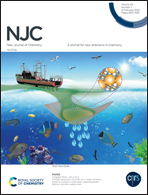The application of ultrasonic treatment and a bis(2-ethylhexyl)sulfosuccinate-based novel ionic liquid for cadmium extraction†
Abstract
A hydrophobic functional ionic liquid (IL) [N4444]AOT based on bis(2-ethylhexyl)sulfosuccinate anions was designed and synthesized for cadmium extraction. To study the characteristics of [N4444]AOT, Fourier transform infrared (FTIR) spectroscopy, hydrogen nuclear magnetic resonance spectroscopy (1H NMR), and thermogravimetric analysis were used. The extraction ability of [N4444]AOT towards Cd under ultrasonic conditions was also investigated. The results showed that more than 95.08% of Cd in a water solution could be extracted with [N4444]AOT under ultrasonic conditions. The results of FTIR and 1H NMR analyses showed that Cd mainly coordinated with the S–O bond provided by [N4444]AOT during extraction. The extraction of Cd from soil with [N4444]AOT was high and reached the value of 62.57%. Furthermore, [N4444]AOT could extract some stable and bound Cd species from the soil, which existed in a weakly acidic, reducible or oxidizable state. The application of [N4444]AOT significantly decreased the bioavailability of Cd in the soil. [N4444]AOT can be a good agent for Cd-contaminated soil remediation without changing the soil properties.



 Please wait while we load your content...
Please wait while we load your content...